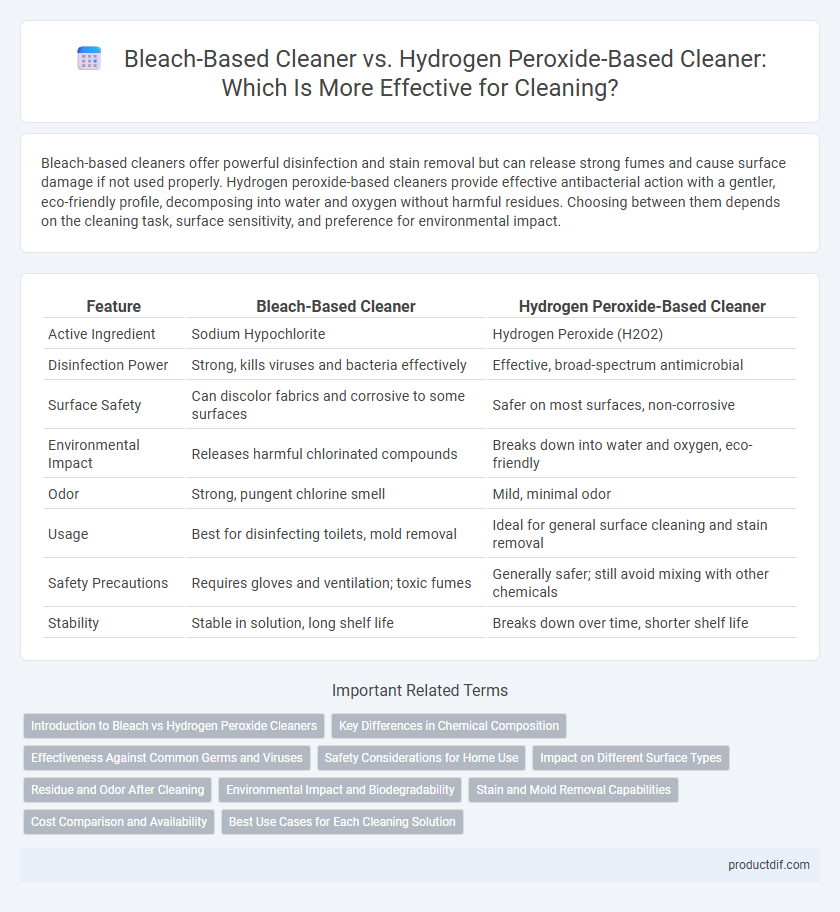Bleach-based cleaners offer powerful disinfection and stain removal but can release strong fumes and cause surface damage if not used properly. Hydrogen peroxide-based cleaners provide effective antibacterial action with a gentler, eco-friendly profile, decomposing into water and oxygen without harmful residues. Choosing between them depends on the cleaning task, surface sensitivity, and preference for environmental impact.
Table of Comparison
| Feature | Bleach-Based Cleaner | Hydrogen Peroxide-Based Cleaner |
|---|---|---|
| Active Ingredient | Sodium Hypochlorite | Hydrogen Peroxide (H2O2) |
| Disinfection Power | Strong, kills viruses and bacteria effectively | Effective, broad-spectrum antimicrobial |
| Surface Safety | Can discolor fabrics and corrosive to some surfaces | Safer on most surfaces, non-corrosive |
| Environmental Impact | Releases harmful chlorinated compounds | Breaks down into water and oxygen, eco-friendly |
| Odor | Strong, pungent chlorine smell | Mild, minimal odor |
| Usage | Best for disinfecting toilets, mold removal | Ideal for general surface cleaning and stain removal |
| Safety Precautions | Requires gloves and ventilation; toxic fumes | Generally safer; still avoid mixing with other chemicals |
| Stability | Stable in solution, long shelf life | Breaks down over time, shorter shelf life |
Introduction to Bleach vs Hydrogen Peroxide Cleaners
Bleach-based cleaners contain sodium hypochlorite, a powerful disinfectant effective at killing a wide range of bacteria, viruses, and fungi, making them ideal for heavy-duty sanitation tasks. Hydrogen peroxide-based cleaners use a milder oxidizing agent, hydrogen peroxide, which breaks down into water and oxygen, offering a safer and eco-friendly alternative for disinfecting surfaces without harsh chemical residues. Both cleaners serve vital roles in maintaining hygiene, with bleach favored for intense germ control and hydrogen peroxide preferred for environmentally sensitive applications.
Key Differences in Chemical Composition
Bleach-based cleaners primarily contain sodium hypochlorite, a powerful oxidizing agent effective at disinfecting and whitening surfaces by releasing chlorine. Hydrogen peroxide-based cleaners rely on H2O2, which decomposes into water and oxygen, offering a safer, eco-friendly alternative with strong antimicrobial properties. The distinct chemical structures influence their reactivity, safety profiles, and environmental impact.
Effectiveness Against Common Germs and Viruses
Bleach-based cleaners are highly effective in killing a wide range of common germs and viruses, including influenza, norovirus, and coronavirus, due to their strong oxidizing properties. Hydrogen peroxide-based cleaners also offer strong antimicrobial activity but are often preferred for sensitive surfaces because they are less corrosive while still effectively inactivating bacteria and viruses like staphylococcus and rhinovirus. Both agents disrupt microbial cell walls and genetic material, but bleach typically provides faster and broader-spectrum disinfection at lower concentrations.
Safety Considerations for Home Use
Bleach-based cleaners contain sodium hypochlorite, which can produce harmful fumes and cause skin irritation, requiring adequate ventilation and protective gloves during use. Hydrogen peroxide-based cleaners break down into water and oxygen, presenting a safer alternative with lower toxicity and minimal respiratory risks. Both should be stored securely, but hydrogen peroxide is preferred for households with children or pets due to its milder chemical profile.
Impact on Different Surface Types
Bleach-based cleaners are highly effective on non-porous surfaces like tiles and glass but can cause discoloration or damage to fabrics, wood, and painted surfaces. Hydrogen peroxide-based cleaners offer a gentler alternative suitable for porous materials such as wood and natural stone, minimizing the risk of surface degradation while still providing strong antimicrobial properties. Selecting the appropriate cleaner depends on the surface composition, with hydrogen peroxide preferred for delicate or sensitive surfaces and bleach reserved for tough, non-porous areas.
Residue and Odor After Cleaning
Bleach-based cleaners often leave a strong, lingering odor and may leave white residues on surfaces, which can require additional rinsing. Hydrogen peroxide-based cleaners typically break down into water and oxygen, leaving minimal residue and a milder, less persistent scent. Choosing hydrogen peroxide can enhance surface cleanliness without the harsh chemical smell associated with bleach.
Environmental Impact and Biodegradability
Bleach-based cleaners release chlorine compounds that can form toxic byproducts, posing risks to aquatic ecosystems and reducing biodegradability. Hydrogen peroxide-based cleaners break down into water and oxygen, minimizing environmental harm and exhibiting high biodegradability. Choosing hydrogen peroxide cleaners supports sustainable cleaning by reducing chemical pollution and promoting safer waste disposal.
Stain and Mold Removal Capabilities
Bleach-based cleaners offer powerful stain and mold removal by effectively breaking down tough organic matter and disinfecting surfaces, making them highly suitable for severe mold infestations and stubborn stains. Hydrogen peroxide-based cleaners provide a safer alternative with strong oxidizing properties that remove stains and mold while being less harsh on surfaces and environmentally friendly. Both solutions are effective, but bleach typically outperforms hydrogen peroxide in fast and deep mold eradication, while hydrogen peroxide excels in delicate or porous materials.
Cost Comparison and Availability
Bleach-based cleaners typically cost less per gallon, making them a budget-friendly option for large-scale cleaning, while hydrogen peroxide-based cleaners usually come at a higher price due to their safer chemical profile. Bleach is widely available in most supermarkets and hardware stores, often found in concentrated forms, whereas hydrogen peroxide cleaners may be found more frequently in health stores and specialty cleaning sections. Both options vary in availability depending on regional regulations and demand, but bleach remains the more accessible product globally.
Best Use Cases for Each Cleaning Solution
Bleach-based cleaners excel in disinfecting high-traffic areas and eliminating tough mold, mildew, and stains on hard, non-porous surfaces such as bathroom tiles and kitchen countertops. Hydrogen peroxide-based cleaners are ideal for delicate surfaces, organic stain removal, and sanitizing spaces with less harsh chemical exposure, making them suitable for countertops, glass, and food preparation areas. Each solution offers powerful cleaning; choosing depends on surface type, stain severity, and desired safety level.
Bleach-based cleaner vs Hydrogen peroxide-based cleaner Infographic

 productdif.com
productdif.com